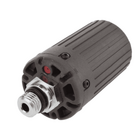Glenn Williams
Contributor
Does your regulator when disconnected from the tank have a self sealing valve or do you have to place your thumb over the opening when rinsing your regulator after a dive? You said you observed some brownish water. My guess is at some point during cleaning/rinsing your gear some water got inside the hoses and flooded the transmitter causing the failure.
Being that the transmitter is not working and probably out of warranty, have you removed the outer cover to see what the innards look like?
Let us know what you find.
Thanks
Glenn
Being that the transmitter is not working and probably out of warranty, have you removed the outer cover to see what the innards look like?
Let us know what you find.
Thanks
Glenn




